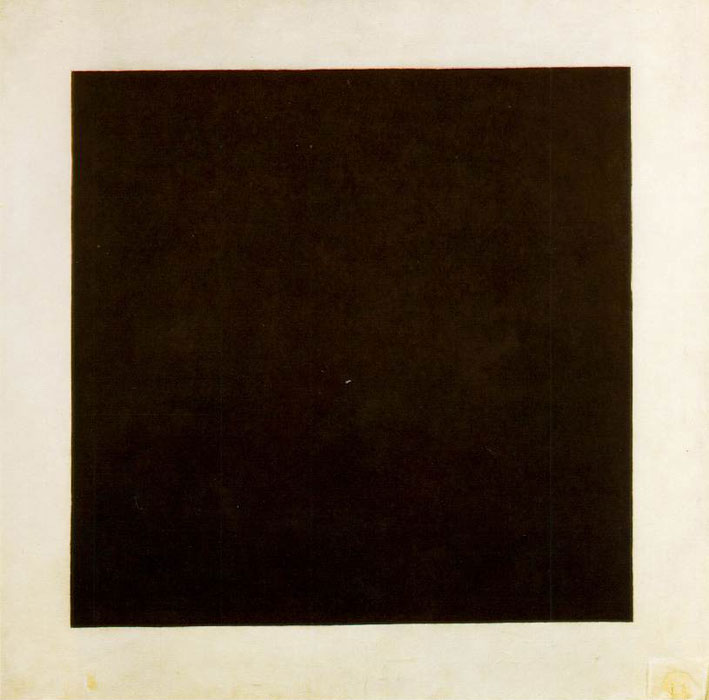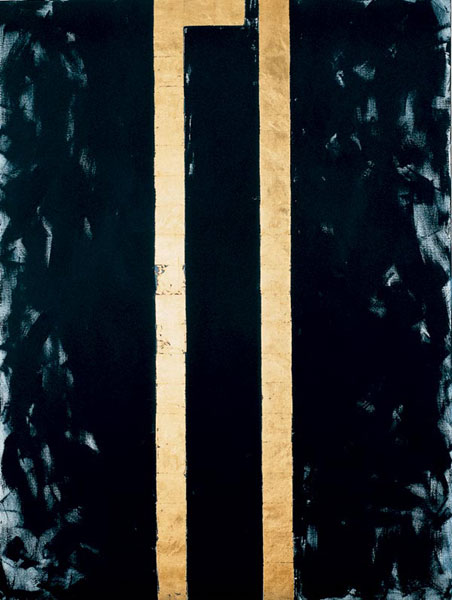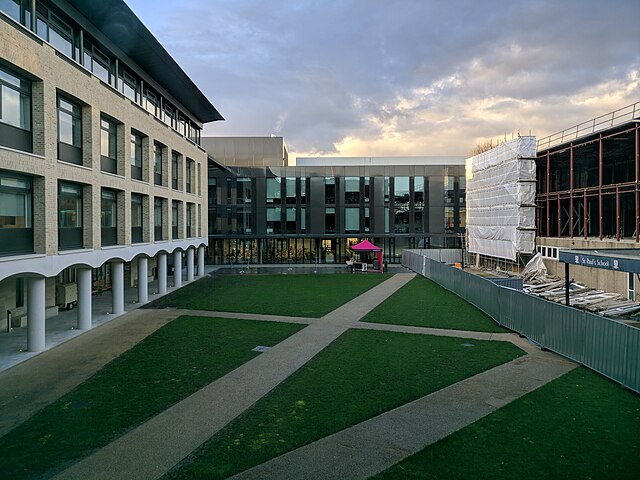Abstract art is an example of a composition which features a level of abstraction. It is often criticised by stereotype for resembling children’s art and requiring no skill to create.[1] This conventional image has formed as a result of traditional Western art, where a work of art ought to represent its subject as closely as possible. Wassily Kandinsky, arguably one of the movement’s most important painters, thought otherwise. He believed that colour, composition, forms and lines could be used in a painting to not only portray an object but express the artists’ feelings and emotions.[2]

Abstraction #

Abstraction, strictly speaking, refers to a work of art that is a departure from reality. For that reason, all art is an abstraction, even photorealist works. The only exception is where the work is the subject it represents, such as My Bed, by Tracey Emin. In reference to abstract art, there are two types: representational and ‘pure’ abstraction.
Any art drawn from reality aims to convey a subject in the painting. One must note that in all cases the original is altered, with forms simplified or schematised, when it is represented by the artist. This makes the final composition an example of an abstracted work of art.
Pure abstraction, also known as concrete art,[3] aims to completely remove all reference to the world and focus purely on the emotions and the subconscious of the artist, represented through colour, form and particularly geometric marks.[4][5] The only problem with pure abstraction is that when a viewer sees a painting the way they interpret the piece may allow them to discern a subject in the painting. The earliest such paintings appeared in the early 20th century – with his free use of colour and imagination Henri Matisse came very close to pure abstraction with paintings such as The Yellow Curtain (1915). Most argue that Malevich’s Black Square (1923) was one of the most iconic earliest paintings whose aim was to create an artwork that is purely abstract. Malevich called his new approach to painting suprematism, where geometric shapes and colour take supremacy over the painting.[6]
History of abstraction in art #
In the late 19th century, as photography started to gain a foothold, artists began to experiment with the idea of abstraction so as not to compete with the camera. Movements such as Impressionism and Expressionism, which did not focus on an accurate depiction of reality, started to appear.[7]


By the beginning of the 20th century, these movements evolved into other more abstract ones, for instance Cubism and Fauvism, pioneered by artists such as Pablo Picasso and Georges Braque. Ultimately, these two movements were the most prominent and opened the door to pure abstraction. Picasso rejected these ideals, leaving artists such as Sonia Delaunay to create a branch of Cubism called Orphism, which aspired to remove any subject in the painting, relying on form and colour to communicate meaning.[8]
By the mid-20th century, during the Nazi rise to power, many artists fled Europe to America. Immigrant artists began to form groups with similar ideals, a prominent such group formed in New York, knows as the abstract expressionists.
Abstract art has now entered mainstream contemporary art. As digital art and illustrations steadily increase in popularity with the onset of tools such as Adobe Photoshop and Illustrator, simplified and abstracted forms, images and icons are becoming more common.
Abstract expressionism #
Abstract expressionism was a post-war movement in the mid-20th century, pioneered by artists such as Jackson Pollock. It evolved from Surrealism and was based around the spontaneity of the artist,[9] who often used this style to express their anxiety, grief and trauma brought about by World War II.[10] The abstract expressionists were primarily based in New York and centred their work around the surrealist idea that artwork ought to come from the unconscious mind, a process known as automatism.[11] Most notable is Pollock’s action painting style[12], where the spontaneity of the artist’s physical actions is the centrepiece of the work, with paint often smeared, splashed or dripped straight onto the canvas.[13]

Colour field is a style of abstract painting that is very closely associated with abstract expressionism, featuring artists such as Mark Rothko and Barnett Newman. Its primary goal was for large, flat areas of colour that gave equal importance to all parts of the canvas,[14] making such artworks examples of ‘pure’ abstraction. Rothko was against this terming and strongly believed that his artwork had a subject.[15] Newman’s work is characterised by areas of colour separated by upright vertical lines, or as he called them, “zips”.[16] Most of his works are purely abstract and the names were given retrospectively years after their creation.[17]
Abstraction in architecture #
 In the early 20th century the Bauhaus German art
school was formed, with an aim to teach modern art, architecture and
design. It started ideas which influence Modernist
architecture to this day. The
original buildings of the Bauhaus school, designed by Walter
Gropius and opened in 1919, exemplified
objectives such as the celebration of industrial materials and
construction techniques and the absence of useless decorations.[18] It
utilised clean lines, elegant geometric shapes and volume and a
well-considered use of light, space and materials.[19] Bauhaus did not
focus on architecture, and did not even offer a course for it until
1927.[20] The schools moved from Weimar to Dessau in 1925, and in 1932
to Berlin, where it was closed by the Nazis a year later. Bauhaus
teaching sought a utopian goal community of artists who would bring art
and architecture into everyday life,[21] by making it affordable and
therefore contributing to society.[22] The ideology believed that
exposed concrete, raw materials and large glass openings would connect
the inhabitants to the outside world as often people spend so much time
indoors.
In the early 20th century the Bauhaus German art
school was formed, with an aim to teach modern art, architecture and
design. It started ideas which influence Modernist
architecture to this day. The
original buildings of the Bauhaus school, designed by Walter
Gropius and opened in 1919, exemplified
objectives such as the celebration of industrial materials and
construction techniques and the absence of useless decorations.[18] It
utilised clean lines, elegant geometric shapes and volume and a
well-considered use of light, space and materials.[19] Bauhaus did not
focus on architecture, and did not even offer a course for it until
1927.[20] The schools moved from Weimar to Dessau in 1925, and in 1932
to Berlin, where it was closed by the Nazis a year later. Bauhaus
teaching sought a utopian goal community of artists who would bring art
and architecture into everyday life,[21] by making it affordable and
therefore contributing to society.[22] The ideology believed that
exposed concrete, raw materials and large glass openings would connect
the inhabitants to the outside world as often people spend so much time
indoors.
Bauhaus influenced many artists who emigrated around the world as a result of the Second World War, many of whom settled in Israel, Western Europe and the USA. The White City in Tel Aviv, for example, consists of over 4000 Bauhaus-style buildings constructed in 1933-1939. At the time Tel Aviv was a small city and the rapid wave of immigration required new housing to be built. Bauhaus was chosen as it was cheaper and favoured function over form, devoid of unnecessary embellishments.[23] Most constructed buildings featured clean, angular lines and narrow and tall “thermometer windows” to handle the intense sunlight and heat, unlike Bauhaus-style buildings in Europe.[24] Although the new St Paul’s School buildings designed by Nicholas Hare Architects are an example of contemporary architecture, they feature key elements of Modernist design, with exposed concrete slabs and large glass windows.
References #
“Why can’t a four-year old paint a Pollock?”. BBC Guides. Retrieved 2019-03-20. ↩︎
“Visionary Spirit; Heroic Capacities”. artnetweb.com. Retrieved 2019-03-06. ↩︎
“Concrete art”. Tate. Retrieved 2019-03-13. ↩︎
“Non-objective art”. Tate. Retrieved 2019-03-13. ↩︎
“Abstract art”. www.tate.org.uk. Retrieved 2019-03-13. ↩︎
“Suprematism”. Tate. Retrieved 2019-03-14. ↩︎
“Formalism”. Tate. Retrieved 2019-03-13. ↩︎
“Orphism”. Tate. Retrieved 2019-03-13. ↩︎
“Abstract expressionism”. Tate. Retrieved 2019-03-13. ↩︎
“Abstract Expressionism Movement Overview”. The Art Story. Retrieved 2019-03-14. ↩︎
“Automatism”. Tate. Retrieved 2019-03-14. ↩︎
Gersh-Nesic, Beth. “Action Painting”. ThoughtCo. Retrieved 2019-03-17. ↩︎
“Action painters”. Tate. Retrieved 2019-03-17. ↩︎
Kunitz, Daniel (2008-05-22). “A Commitment to Color”. The New York Sun. Retrieved 2019-03-17. ↩︎
Pappas, Andrea (2007-07-01). “Haunted Abstraction”. Journal of Modern Jewish Studies. 6 (2): 167–183. doi:10.1080/14725880701423055. ISSN 1472-5886. S2CID 147459296. ↩︎
Dorment, Richard (2002-09-17). “Thin lines, thick with emotion”. The Daily Telegraph : Britain’s Best-Selling Quality Daily. ISSN 0307-1235. Retrieved 2019-03-17. ↩︎
“Exposing Creation: Portraits of Newman and His Paintings – In Focus”. Tate. See footnote 12. Retrieved 2019-03-17. ↩︎
“Abstraction in Architecture”. artnetweb.com. Retrieved 2019-03-06. ↩︎
“Albers and Moholy-Nagy: From the Bauhaus to the New World”. Tate Modern. 2006-03-09. Retrieved 2019-03-27. ↩︎
“Bauhaus Building by Walter Gropius (1925–26)”. www.bauhaus-dessau.de. Retrieved 2019-03-27. ↩︎
“Exhibition Guide: Shape of Light”. Tate. Retrieved 2019-03-27. ↩︎
“Bauhaus”. Tate. Retrieved 2019-03-17. ↩︎
Barak, Naama. “Bauhaus turns 100 in Tel Aviv’s White City”. Israel21c. Retrieved 2019-03-27. ↩︎
Grant, Linda (2004-06-08). “Unesco celebrates Tel Aviv”. Retrieved 2019-03-17. ↩︎